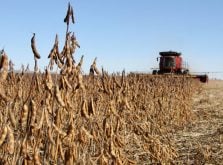A group of senior federal, provincial and animal agriculture officials recommends that Canada develop a comprehensive plan to cope with the next animal disease outbreak, which they say is inevitable.
The proposed National Farmed Animal Health Strategy would include better surveillance and prevention measures, traceability, a co-ordinated plan for responding to an outbreak and a well-developed communications plan both for dealing with domestic consumers and also Canada’s foreign animal-product customers.
As outlined Feb. 5 to the Dairy Farmers of Canada policy convention by Norm Willis, former chief veterinary officer for Canada and former president of the international animal health organization, the proposal calls for development of programs, policies and solutions beginning now and being completed by 2015.
Read Also

Manitoba extends Crown land rent freeze
Manitoba government links the continued rental rate freeze on grazing and forage leases to economic and environmental challenges facing the industry
He said the health of Canada’s agriculture, human population and trade potential are at stake.
The effort would be directed by the council, comprising senior officials and supported by a permanent secretariat.
The plan, including research, co-ordinated food safety protocols and communications, would be costly, said Willis. He said it presumably would be funded by all involved sectors, including farm organizations.
“The public expects us to be ready,” he told delegates.
“This is a turning point in the national farmed animal health system. We can’t predict where and when future threats will come and we have to be ready.”
Willis said Canada’s experience dealing with foot-and-mouth, BSE and avian influenza showed a lack of co-ordination, direction and national plan.
He said a new animal disease “falls from the sky on average every eight months.”
In an interview after the speech, he said it is crucial that farm groups and governments begin now to build a credible surveillance, prevention, reactive and communications plan.
“I guess I’m almost pleading to say we have a period in time when we’re not in a crisis mode,” he said.
“Now is the time to develop this and put this in place and work out these arrangements, not at the time of a crisis.”
Part of the plan would be to convince the rest of the world that in the event of an outbreak, the country could be divided into zones with the affected area isolated.
He said a national line could be drawn north to south, just east of the Manitoba-Ontario border. In some cases, the zone of isolation could be smaller.
The Paris-based World Organization for Animal Health approves of the concept of zones, as long as the affected country has a credible argument that the disease has been isolated and credible ways to prove there is no spread.
Delegates to the DFC conference were generally supportive but one proposal on animal welfare caught their uneasy attention.
Willis said to maintain credibility with the Canadian public, the strategy must include “animal care and welfare practices that have a basis in science and reflect societal ethics.”
A number of delegates worried that this would open the gates for extreme animal rights advocates to help write standards for farming practices.
Manitoba delegate Bill Swan said his provincial government did not use a science-based test in its policy on hog barns and their polluting potential.
“The animal welfare part is a very, very tough one,” Willis conceded.
But he also said farmers cannot afford to “put their heads in the sand” and ignore public concerns about animal care practices because politicians listen to voters.
He said the industry should do a better job of communicating with the public about responsible farm animal care practices.














